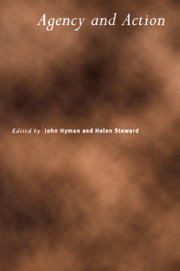Book contents
- Frontmatter
- Contents
- Preface
- Notes on Contributors
- Agency and Actions
- Two Ways of Explaining Actions
- Anscombe on ‘Practical Knowledge’
- Action, the Act Requirement and Criminal Liability
- Emotion, Cognition and Action
- Kantian Autonomy
- The Structure of Orthonomy
- Normativity and the Will
- Can Libertarians Make Promises?
- Intention as Faith
- The Destruction of the World Trade Center and the Law on Event-identity
Intention as Faith
Published online by Cambridge University Press: 07 September 2010
- Frontmatter
- Contents
- Preface
- Notes on Contributors
- Agency and Actions
- Two Ways of Explaining Actions
- Anscombe on ‘Practical Knowledge’
- Action, the Act Requirement and Criminal Liability
- Emotion, Cognition and Action
- Kantian Autonomy
- The Structure of Orthonomy
- Normativity and the Will
- Can Libertarians Make Promises?
- Intention as Faith
- The Destruction of the World Trade Center and the Law on Event-identity
Summary
Introduction
What, if anything, has faith to do with intention?’ By ‘faith’ I have in mind the attitude described by William James:
Suppose … that I am climbing in the Alps, and have had the illluck to work myself into a position from which the only escape is by a terrible leap. Being without similar experience, I have no evidence of my ability to perform it successfully; but hope and confidence in myself make me sure I shall not miss my aim, and nerve my feet to execute what without those subjective emotions would perhaps have been impossible. But suppose that, on the contrary, the emotions of fear and mistrust preponderate; or suppose that…I feel it would be sinful to act upon an assumption unverified by previous experience,—why, then I shall hesitate so long that at last, exhausted and trembling, and launching myself in a moment of despair, I miss my foothold and roll into the abyss.…There are then cases where faith creates its own verification. Believe, and you shall be right, for you shall save yourself; doubt, and you shall again be right, for you shall perish.
The climber has ‘no evidence’ about his ability to leap across the chasm: his faith goes beyond evidence.3 The desire to leap across enables the climber to believe he will leap across: his faith is wishful. Belief that he will leap across enables him to leap across: his faith is self-fulfilling. When it comes to faith, the ‘no evidence’ issue is usually at the fore; but I shall mostly ignore it here, and focus on faith as a wishful and self-fulfilling attitude.
- Type
- Chapter
- Information
- Agency and Action , pp. 243 - 258Publisher: Cambridge University PressPrint publication year: 2004
- 16
- Cited by



